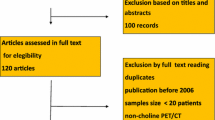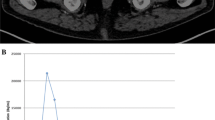Abstract
Purpose
18F-Fluoroethylcholine (18F-FECh) is excreted via the urinary system with high activity accumulation in the urinary bladder. Furosemide and oral hydration can be administered concomitantly to reduce urinary activity to provide better detectability of retroperitoneal and pelvic lesions. Currently it is unknown if there is any effect of furosemide on 18F-FECh uptake in organs, tissues and tumour lesions and the extent to which image quality along the urinary tract may be improved by furosemide.
Methods
We retrospectively analysed 217 18F-FECh PET/CT examinations from 213 patients with known prostate cancer (PCa), performed either with oral hydration (109) or furosemide 20 mg together with oral hydration (108). Maximum 18F-FECh uptake in different organs, tissues, lymph nodes and osseous metastases was quantified in terms of standardized uptake value (SUV) in a volume of interest and compared between the two groups. To characterize the impact of furosemide on lesion detectability a three-point rating scale was used to assess the presence of focal activity spots in the ureters and of perivesicular artefacts.
Results
Patient characteristics and distribution of tumour lesions were well balanced between the two groups. Overall, SUVmax values from normal organs were increased after furosemide compared to the values in patients scanned without furosemide. Significant changes were observed in the salivary glands, liver, spleen, pancreas, kidneys, gluteus muscle and perirenal fat. SUVmax values were significantly decreased after furosemide in lymph node metastases (SUVmax 4.81 ± 2.68 vs. 6.48 ± 4.22, p = 0.0006), but not in osseous metastases. Evaluation of image quality along the urinary tract revealed significantly better depiction of the perivesicular space and significantly less focal tracer accumulation in the ureters in patients receiving furosemide, but the number of detected lymph nodes was not significantly different.
Conclusion
Furosemide administration reduced choline uptake in tumour lesions, especially significant in pelvic lymph node metastases. Although furosemide administration improved image quality, optimal image quality may also be obtained by adequate hydration without the risk of diminishing choline uptake in PCa lesions. Therefore a controlled hydration protocol seems more appropriate than administration of furosemide.




Similar content being viewed by others
References
Jilg CA, Rischke HC, Reske SN, Henne K, Grosu AL, Weber W, et al. Salvage lymph node dissection with adjuvant radiotherapy for nodal recurrence of prostate cancer. J Urol. 2012;188:2190–7. doi:10.1016/j.juro.2012.08.041.
Castellucci P, Fuccio C, Nanni C, Santi I, Rizzello A, Lodi F, et al. Influence of trigger PSA and PSA kinetics on 11C-choline PET/CT detection rate in patients with biochemical relapse after radical prostatectomy. J Nucl Med. 2009;50:1394–400. doi:10.2967/jnumed.108.061507.
Jadvar H. Prostate cancer: PET with 18F-FDG, 18F- or 11C-acetate, and 18F- or 11C-choline. J Nucl Med. 2011;52:81–9. doi:10.2967/jnumed.110.077941.
Rischke HC, Knippen S, Kirste S, Grosu AL. Treatment of recurrent prostate cancer following radical prostatectomy: the radiation-oncologists point of view. Q J Nucl Med Mol Imaging. 2012;56:409–20.
Beheshti M, Imamovic L, Broinger G, Vali R, Waldenberger P, Stoiber F, et al. 18F choline PET/CT in the preoperative staging of prostate cancer in patients with intermediate or high risk of extracapsular disease: a prospective study of 130 patients. Radiology. 2010;254:925–33. doi:10.1148/radiol.09090413.
Jilg CA, Schultze-Seemann W, Drendel V, Vach W, Wieser G, Krauss T, et al. Detection of lymph node metastasis in patients with nodal prostate cancer relapse using 18F/11C-choline positron emission tomography/computerized tomography. J Urol. 2014;192:103–11. doi:10.1016/j.juro.2013.12.054.
Rigatti P, Suardi N, Briganti A, Da Pozzo LF, Tutolo M, Villa L, et al. Pelvic/retroperitoneal salvage lymph node dissection for patients treated with radical prostatectomy with biochemical recurrence and nodal recurrence detected by [11C]choline positron emission tomography/computed tomography. Eur Urol. 2011;60:935–43. doi:10.1016/j.eururo.2011.07.060.
Apolo AB, Pandit-Taskar N, Morris MJ. Novel tracers and their development for the imaging of metastatic prostate cancer. J Nucl Med. 2008;49:2031–41. doi:10.2967/jnumed.108.050658.
DeGrado TR, Baldwin SW, Wang S, Orr MD, Liao RP, Friedman HS, et al. Synthesis and evaluation of (18)F-labeled choline analogs as oncologic PET tracers. J Nucl Med. 2001;42:1805–14.
Kamel EM, Jichlinski P, Prior JO, Meuwly JY, Delaloye JF, Vaucher L, et al. Forced diuresis improves the diagnostic accuracy of 18F-FDG PET in abdominopelvic malignancies. J Nucl Med. 2006;47:1803–7.
Anjos DA, Etchebehere EC, Ramos CD, Santos AO, Albertotti C, Camargo EE. 18F-FDG PET/CT delayed images after diuretic for restaging invasive bladder cancer. J Nucl Med. 2007;48:764–70. doi:10.2967/jnumed.106.036350.
Ceriani L, Suriano S, Ruberto T, Giovanella L. Could different hydration protocols affect the quality of 18F-FDG PET/CT images? J Nucl Med Technol. 2011;39:77–82. doi:10.2967/jnmt.110.081265.
Hara T, Kosaka N, Kishi H. Development of (18)F-fluoroethylcholine for cancer imaging with PET: synthesis, biochemistry, and prostate cancer imaging. J Nucl Med. 2002;43:187–99.
Kwee SA, Wei H, Sesterhenn I, Yun D, Coel MN. Localization of primary prostate cancer with dual-phase 18F-fluorocholine PET. J Nucl Med. 2006;47:262–9.
Piel M, Bauman A, Baum RP, Hohnemann S, Klette I, Wortmann R, et al. Improved automated synthesis of [18F]fluoroethylcholine as a radiotracer for cancer imaging. Bioorg Med Chem. 2007;15:3171–5. doi:10.1016/j.bmc.2007.02.038.
Dachman AH, MacEneaney PM, Adedipe A, Carlin M, Schumm LP. Tumor size on computed tomography scans: is one measurement enough? Cancer. 2001;91:555–60.
Rischke HC, Nestle U, Fechter T, Doll C, Volegova-Neher N, Henne K, et al. 3 Tesla multiparametric MRI for GTV-definition of dominant intraprostatic lesions in patients with prostate cancer – an interobserver variability study. Radiat Oncol. 2013;8:183. doi:10.1186/1748-717X-8-183.
Polycarpou I, Thielemans K, Manjeshwar R, Aguiar P, Marsden PK, Tsoumpas C. Comparative evaluation of scatter correction in 3D PET using different scatter-level approximations. Ann Nucl Med. 2011;25:643–9. doi:10.1007/s12149-011-0514-y.
Heinisch M, Dirisamer A, Loidl W, Stoiber F, Gruy B, Haim S, et al. Positron emission tomography/computed tomography with F-18-fluorocholine for restaging of prostate cancer patients: meaningful at PSA <5 ng/ml? Mol Imaging Biol. 2006;8:43–8. doi:10.1007/s11307-005-0023-2.
Roberts FO, Gunawardana DH, Pathmaraj K, Wallace A, U PL, Mi T, et al. Radiation dose to PET technologists and strategies to lower occupational exposure. J Nucl Med Technol. 2005;33:44–7.
Schwarzenbock SM, Kurth J, Gocke C, Kuhnt T, Hildebrandt G, Krause BJ. Role of choline PET/CT in guiding target volume delineation for irradiation of prostate cancer. Eur J Nucl Med Mol Imaging. 2013;40 Suppl 1:S28–35. doi:10.1007/s00259-013-2404-0.
Michel V, Yuan Z, Ramsubir S, Bakovic M. Choline transport for phospholipid synthesis. Exp Biol Med (Maywood). 2006;231:490–504.
Deves R, Krupka RM. The binding and translocation steps in transport as related to substrate structure. A study of the choline carrier of erythrocytes. Biochim Biophys Acta. 1979;557:469–85.
Simon JR, Atweh S, Kuhar MJ. Sodium-dependent high affinity choline uptake: a regulatory step in the synthesis of acetylcholine. J Neurochem. 1976;26:909–22.
O’Regan S, Collier B. Factors affecting choline transport by the cat superior cervical ganglion during and following stimulation, and the relationship between choline uptake and acetylcholine synthesis. Neuroscience. 1981;6:511–20.
Muller SA, Holzapfel K, Seidl C, Treiber U, Krause BJ, Senekowitsch-Schmidtke R. Characterization of choline uptake in prostate cancer cells following bicalutamide and docetaxel treatment. Eur J Nucl Med Mol Imaging. 2009;36:1434–42. doi:10.1007/s00259-009-1117-x.
Toyohara J, Hayashi A, Sato M, Tanaka H, Haraguchi K, Yoshimura Y, et al. Rationale of 5-(125)I-iodo-4'-thio-2'-deoxyuridine as a potential iodinated proliferation marker. J Nucl Med. 2002;43:1218–26.
Hakalahti L, Vihko P, Henttu P, Autio-Harmainen H, Soini Y, Vihko R. Evaluation of PAP and PSA gene expression in prostatic hyperplasia and prostatic carcinoma using northern-blot analyses, in situ hybridization and immunohistochemical stainings with monoclonal and bispecific antibodies. Int J Cancer. 1993;55:590–7.
Culliford SJ, Bernhardt I, Ellory JC. Activation of a novel organic solute transporter in mammalian red blood cells. J Physiol. 1995;489(Pt 3):755–65.
Kim GH. Long-term adaptation of renal ion transporters to chronic diuretic treatment. Am J Nephrol. 2004;24:595–605. doi:10.1159/000082314.
Vormfelde SV, Sehrt D, Toliat MR, Schirmer M, Meineke I, Tzvetkov M, et al. Genetic variation in the renal sodium transporters NKCC2, NCC, and ENaC in relation to the effects of loop diuretic drugs. Clin Pharmacol Ther. 2007;82:300–9. doi:10.1038/sj.clpt.6100131.
Haas M, Forbush 3rd B. The Na-K-Cl cotransporters. J Bioenerg Biomembr. 1998;30:161–72.
Russell JM. Sodium-potassium-chloride cotransport. Physiol Rev. 2000;80:211–76.
Maki M, Miyazaki H, Niisato N, Morihara T, Marunaka Y, Kubo T. Blockers of K+/Cl- transporter/channels diminish proliferation of osteoblastic cells. Biomed Res. 2009;30:137–40.
Shiozaki A, Miyazaki H, Niisato N, Nakahari T, Iwasaki Y, Itoi H, et al. Furosemide, a blocker of Na+/K+/2Cl- cotransporter, diminishes proliferation of poorly differentiated human gastric cancer cells by affecting G0/G1 state. J Physiol Sci. 2006;56:401–6. doi:10.2170/physiolsci.RP010806.
Hiraoka K, Miyazaki H, Niisato N, Iwasaki Y, Kawauchi A, Miki T, et al. Chloride ion modulates cell proliferation of human androgen-independent prostatic cancer cell. Cell Physiol Biochem. 2010;25:379–88. doi:10.1159/000303042.
Dikshit K, Vyden JK, Forrester JS, Chatterjee K, Prakash R, Swan HJ. Renal and extrarenal hemodynamic effects of furosemide in congestive heart failure after acute myocardial infarction. N Engl J Med. 1973;288:1087–90. doi:10.1056/NEJM197305242882102.
Jhund PS, McMurray JJ, Davie AP. The acute vascular effects of frusemide in heart failure. Br J Clin Pharmacol. 2000;50:9–13.
Dormans TP, Pickkers P, Russel FG, Smits P. Vascular effects of loop diuretics. Cardiovasc Res. 1996;32:988–97.
Wiemer G, Fink E, Linz W, Hropot M, Scholkens BE, Wohlfart P. Furosemide enhances the release of endothelial kinins, nitric oxide and prostacyclin. J Pharmacol Exp Ther. 1994;271:1611–5.
Green TP, Thompson TR, Johnson DE, Lock JE. Furosemide promotes patent ductus arteriosus in premature infants with the respiratory-distress syndrome. N Engl J Med. 1983;308:743–8. doi:10.1056/NEJM198303313081303.
Cotton R, Suarez S, Reese J. Unexpected extra-renal effects of loop diuretics in the preterm neonate. Acta Paediatr. 2012;101:835–45. doi:10.1111/j.1651-2227.2012.02699.x.
Mancino M, Ametller E, Gascon P, Almendro V. The neuronal influence on tumor progression. Biochim Biophys Acta. 1816;2011:105–18. doi:10.1016/j.bbcan.2011.04.005.
Conflicts of interest
None.
Author information
Authors and Affiliations
Corresponding author
Additional information
H. Christian Rischke and Teresa Beck contributed equally to this work.
Rights and permissions
About this article
Cite this article
Rischke, H.C., Beck, T., Vach, W. et al. Furosemide diminishes 18F-fluoroethylcholine uptake in prostate cancer in vivo. Eur J Nucl Med Mol Imaging 41, 2074–2082 (2014). https://doi.org/10.1007/s00259-014-2829-0
Received:
Accepted:
Published:
Issue Date:
DOI: https://doi.org/10.1007/s00259-014-2829-0




